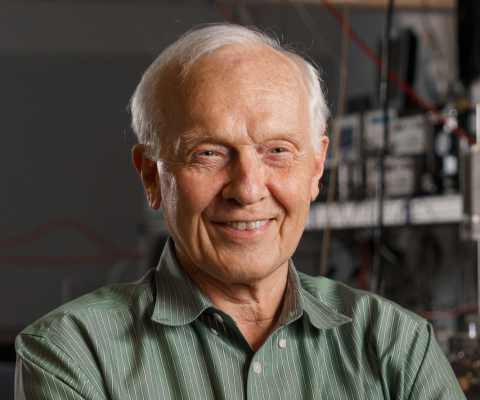Paul Corkum
The fastest measurements in the world: UofO researcher earns Wolf Prize for ground-breaking contributions to attosecond physics
Dr. Paul Corkum – a distinguished professor at the University of Ottawa, principal research officer at the NRC and co-director of the NRC-uOttawa Joint Centre for Extreme Photonics – is co-recipient of the prestigious Wolf Prize in Physics for 2022. He shares the prize with European physicists Ferenc Krausz and Anne l’Huillier.
Dr. Corkum is a pioneer in the development of a type of physics called attosecond science, which lasts one billionth of a billionth of a second.
“We’ve learned how to make the fastest measurements in the world; the fastest measurements that humans can make by a factor of 100 over what it was before,” he explains the work recognized by the Wolf Prize. “In the process, we found a way to force lasers to make soft x-rays, where you would not use lasers before – you would have used something more complicated before.”
“The third thing is we found that when you radiate materials with light, there is an extreme response that you can understand.”
“It’s really all about waves,” he says in offering an analogy to explain the research. “Think about going to the Bay of Fundy or the ocean,” says the native of Saint John, N.B., “and looking at the waves coming in. There might be seaweed on a rock, and you would see the wave pick the seaweed up and then return it with a crash onto the rock from which it left. So we’re going to do almost exactly the same thing with an atom. The wave, which is a light, is a wave of force on an electron – just like water is a wave of force on the seaweed moving it up and down. When laser light hits an atom, the electron is pulled free of the atom and it moves just like the seaweed would do before crashing into the atom from which it left, just like the seaweed crashes into a rock from which it left. If it gets caught, it gives out a flash of light. That would be like the bang of the seaweed against the rock.
“That flash of light is the very short pulses that I’m talking about,” he explains of the fundamental research. “So this is about high intensity light interacting with materials that can be atoms (we started with atoms) or it can be molecules; and we now know it can be transparent solids; and maybe even metals. We’re starting to look at metals.”
The son of a fisherman and tugboat captain, Dr. Corkum spent much of his youth around boats, sailing with his father and working on various types of engines. He says he owes his career to his high school physics teacher, Anthony Kennett.
“He told us that if you read an equation, it has to work out dimensionally. You have to think about what dimensions were involved in one side of the equation and what dimensions were involved in the other side of the equation; if it didn’t work out dimensionally; it wasn’t a good equation.”
“I thought, ‘This is really neat.’ And so, as we went through physics, I saw this as such a logical field that I liked very much.”

